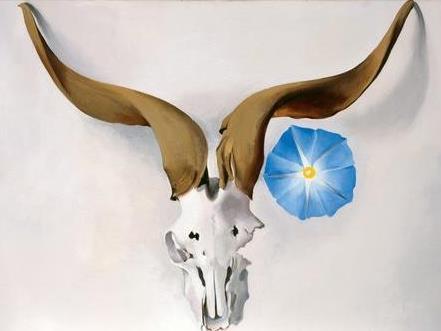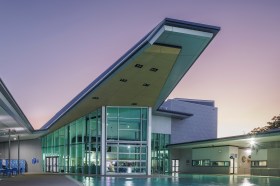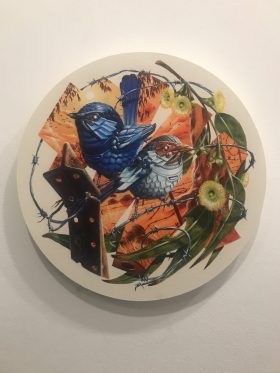Georgia O’Keeffe Ram’s Head, Blue Morning Glory 1938, Georgia O’Keeffe Museum, gift of The Burnett Foundation © Georgia O’Keeffe Museum.
Featuring a small collection of works by three artists, Australians Margaret Preston and Grace Cossington Smith along with American artist Georgia O’Keeffe, Making Modernism doesn’t quite live up to its ambitious title.
Did any of these three artists really play an important role in making modernism? Art scholars may debate that, but the works on display here don’t make a convincing argument and is it just expediency or political correctness that put these three artists together?
The curatorial notes in the excellent catalogue of Making Modernism are quick to say that gender wasn’t a consideration but it does look that way. It’s clear that very little of the work was revolutionary in its style. In contemporary parlance, the modernists were ‘disruptive’ but there is scant evidence of that quality on display. Indeed, you could say there is more conservatism than innovation.
The exhibition opens with Margaret Preston (1875–1963) whose work is the most interesting of the three; it’s also the most instantly recognisable with her distinctive style of flowers, teacups and marvelous woodcuts of Sydney Harbour. Thea Proctor’s Tea Party (1924), Implement Blue (1927), and Aboriginal Flowers (1928) are some of the highlights, along with her wonderful self portrait from 1930. There are half a dozen woodcuts on display, showing Preston’s typical understanding of line and form. Interestingly, almost all of these mentioned works are owned by the Art Gallery. Whilst that’s a tribute to the AGNSW’s comprehensive holding of Preston’s work, it does beg the question about their place in a ticketed exhibition.
Next is Grace Cossington Smith with a good sample of interiors, landscapes, and flowers. Two early works, The Sock Knitter (1915) and Study of a Head: Self Portrait (1916) show the significant talent she displayed as an art student. Some more portraits would be a worthy inclusion in the show. The 1928-29 works The Curve of the Bridge and The Bridge in Building reveal an interest in the changing urban environment, both physically and as a metaphor for greater societal shifts. The Lacquer Room (1935) shows many typically modernist techniques but somehow lacks vivacity. It is really the landscapes and floral works that are at the heart of her art practice in the exhibition. The latest work on display, The Window from 1956, shows again a very domestic focus.
The show concludes with Georgia O’Keeffe whose 1938 work Ram’s Head, Blue Morning Glory is the signature piece of the exhibition. Although well-known for her fascination with bones and such agricultural relics, this is the only such work in the show. There are lots of flowers, some desert landscapes, and a few more abstract works. Blue Line (1919) is worth a discussion about female sexuality – the same could be said for Preston’s 1934 Monstera Deliciosa works. Church Steeple (1930) adds a touch of worship in a hot clime and identifies the artist as the desert-dweller in New Mexico. Two later works, In the Patio V111 (1950) and Pink and Green (1960) are interesting examples of her changing style. There is also a video about the artist, an excerpt of the documentary Georgia O’Keeffe made in 1977.
Making Modernism is hung in discrete sections allowing the viewer to absorb each artist individually. As well as the works, there are various eclectic ephemera displayed in glass cases. There is plenty of room to meander through the exhibition or step back and admire. The accompanying catalogue, edited by Lesley Harding and Denise Mimmocchi, contains many insightful essays and will be a meaningful addition to your bookshelf.
It is hard to see what unites these three artists apart for a few inevitable similarities in style and subject matter. It’s also doubtful that they really had very much impact at all on the development of modernism. That said, they were women making art in the modernist period, so perhaps that will suffice. And there are enough interesting works on display to make this a worthwhile expedition to the Art Gallery.
Rating: 3 1/2 stars out of 5
Making Modernism
Art Gallery of NSW
Running until 2 October 2017.





